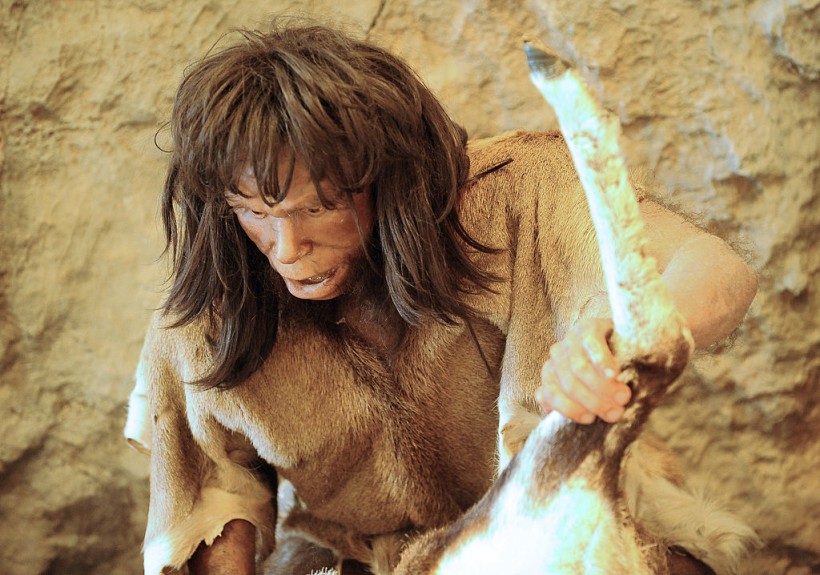A recent study indicates that an infant hip bone fossil discovered in France might have been part of an ancestral Homo sapiens lineage, showing slight distinctions from today's humans.
The result of the study, titled "Anatomically modern human in the Châtelperronian hominin collection from the Grotte du Renne (Arcy-sur-Cure, Northeast France)" published in Scientific Reports, implies that the European group traditionally categorized as Neanderthals might have included both Neanderthals and contemporary humans coexisting, as researchers have pointed out.

View taken on July 8, 2010 of a mannequin of a Tautavel Man, an ancestor of Neanderthal Man, presented at the prehistoric museum in Tautavel.
Neither a Modern Human Nor a Neanderthal
In the Grotte du Renne cave, where the remains of 11 Neanderthals were unearthed, a hip bone was discovered alongside these ancient individuals. The intriguing aspect is that this cave was subsequently inhabited by anatomically modern humans (AMHs), suggesting a period of coexistence between the child whose hip bone was found and the now-extinct Neanderthals.
The researchers compared this artifact with 32 modern baby bones and two Neanderthal baby bones. Their analysis revealed that the hip bone's shape diverged from both Neanderthal and modern human bone shapes, albeit exhibiting subtle proximity to the anatomically modern human morphology.
In the study, the team suggested that the hip bone could belong to an early lineage of anatomically modern humans characterized by slight morphological distinctions from contemporary humans.
An earlier study disclosed that an ancient skull, originating from a juvenile who existed around 300,000 years ago in China, could potentially pertain to an entirely novel human species. Unearthed in Hualongdong, China, in 2019, the fossilized remains encompassed elements such as a jaw, skull, and leg bones.
The intriguing aspect that confounded experts was the lack of correspondence between the individual's facial characteristics and the lineages that diverged to ultimately yield Neanderthals, Denisovans, and modern humans.
This incongruity prompted speculation that an unknown branch in the human family tree might be absent from current understanding. The recent revelation aligns with this notion, revealing a fresh layer of insight into human evolution.
READ ALSO: 45,000-Year-Old Woman's Facial Approximation Reveals Ancient Human-Neanderthal Features
Meet the Châtelperronian
The Châtelperronian, possibly the final stage of Neanderthal culture, raised disputes as some believed its artifacts were from modern humans.
The controversy emerged due to evidence of modern humans in Western Europe around 42,000 years ago, challenging the notion of an exclusive Neanderthal association with Châtelperronian artifacts dating back to 44,500 to 41,000 years ago.
Paleoanthropologists contrasted this infant's hip bone with corresponding bones from two Neanderthal infants and 32 contemporary human newborns. They observed distinct dissimilarities between the Grotte du Renne fossil and Neanderthal bone structures, along with slight deviations from the anatomy of modern humans.
Chris Stringer, a paleoanthropologist from the Natural History Museum in London who was not involved in the study, expressed astonishment at discovering a Homo sapiens fossil in a Châtelperronian context.
The hip bone lacks any indications of disease that could explain its divergence from typical Neanderthal or modern-human bones, according to Maureille. Despite the possibility of disturbance in the layer of soil where the bone was discovered, previous research suggested the strata remained relatively undisturbed over time.
Should the discovery withstand additional examination, it suggests that Homo sapiens and Neanderthals coexisted during the Châtelperronian era, implying potential interactions between the two, as indicated by Stringer. Further study on newborn bones from that period could provide additional insights into their origins, according to Maureille.
RELATED ARTICLE: DNA Analysis of 2-million-year-old Fossilized Teeth Reveals Distant Cousin of Hominids
Check out more news and information on Human Evolution in Science Times.














